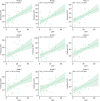Computational peptide discovery with a genetic programming approach
- PMID: 38570405
- PMCID: PMC11416381
- DOI: 10.1007/s10822-024-00558-0
Computational peptide discovery with a genetic programming approach
Abstract
The development of peptides for therapeutic targets or biomarkers for disease diagnosis is a challenging task in protein engineering. Current approaches are tedious, often time-consuming and require complex laboratory data due to the vast search spaces that need to be considered. In silico methods can accelerate research and substantially reduce costs. Evolutionary algorithms are a promising approach for exploring large search spaces and can facilitate the discovery of new peptides. This study presents the development and use of a new variant of the genetic-programming-based POET algorithm, called POET , where individuals are represented by a list of regular expressions. This algorithm was trained on a small curated dataset and employed to generate new peptides improving the sensitivity of peptides in magnetic resonance imaging with chemical exchange saturation transfer (CEST). The resulting model achieves a performance gain of 20% over the initial POET models and is able to predict a candidate peptide with a 58% performance increase compared to the gold-standard peptide. By combining the power of genetic programming with the flexibility of regular expressions, new peptide targets were identified that improve the sensitivity of detection by CEST. This approach provides a promising research direction for the efficient identification of peptides with therapeutic or diagnostic potential.
Keywords: CEST MRI; Contrast agent; Evolutionary algorithm; Genetic programming; Peptide discovery; Regular expressions.
© 2024. The Author(s).
Conflict of interest statement
The authors declare no Conflict of interest.
Figures











Update of
-
Computational Peptide Discovery with a Genetic Programming Approach.Res Sq [Preprint]. 2023 Sep 1:rs.3.rs-3307450. doi: 10.21203/rs.3.rs-3307450/v1. Res Sq. 2023. Update in: J Comput Aided Mol Des. 2024 Apr 3;38(1):17. doi: 10.1007/s10822-024-00558-0. PMID: 37693481 Free PMC article. Updated. Preprint.
References
-
- Hökfelt T et al (2000) Neuropeptides: an overview. Neuropharmacology 39:1337–1356 - PubMed
-
- Zhang L-J, Gallo RL (2016) Antimicrobial peptides. Curr Biol 26:14–19 - PubMed
-
- Calvete JJ, Sanz L, Angulo Y, Lomonte B, Gutiérrez JM (2009) Venoms, venomics, antivenomics. FEBS Lett 583:1736–1743 - PubMed
-
- King GF (2011) Venoms as a platform for human drugs: translating toxins into therapeutics. Expert Opin Biol Ther. 11:1469–1484 - PubMed
MeSH terms
Substances
Grants and funding
LinkOut - more resources
Full Text Sources
Medical

